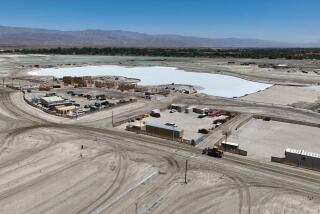Is Disney ready to make big thunder?
Nearly two decades ago, former Walt Disney Co. Chairman Michael Eisner ordered up a grand plan for Southern California. “Amaze me,” he told his staff.
They brought him visions of a massive expansion near Disneyland that included an international theme park, three resort hotels and a 6-acre lake.
That vision never came to fruition, but Disney did open a second theme park in 2001 -- part of a larger goal to build up the Disney Resort and entice tourists to stay longer, like they do in Orlando.
Now, Disney is once again mulling its third act.
Disney won’t say what the latest plan is for Anaheim, but sources familiar with the planning process said Disney wants to mimic its Florida blueprint in Anaheim: add time-share units, bring its popular cruise line to the West Coast and zero in on high-end consumers with boutique hotels. New attractions for its lackluster California Adventure are in the works, and Disney is giving fresh consideration to its long-promised third theme park.
Now in complete recovery from 9/11 -- and sitting on a pile of cash after posting 30% revenue increases following its successful 50th anniversary -- Disney is looking ambitiously toward the future.
“It’s about changing Anaheim into Orlando -- making this into a national and international tourist space,” said blogger Jim Hill, a Disney watchdog.
But Disney’s ambitions are ruffling feathers in Anaheim, where some city leaders believe the corporate giant has tried to bully a town that has been its ally for more than 50 years.
The Walt Disney Co. sued the city last month to protect zoning in the 2.2-square-mile Resort District and block construction of a residential project that includes affordable housing. This week, it joined business leaders in seeking a ballot initiative that would lock in the resort-themed zoning it desired and require a citywide vote before changes could be made.
Corporate attorneys succeeded in forcing a councilwoman to abstain from voting on the housing proposal. And it held confidential meetings with city officials, presenting to council members a preview of some of their closely guarded plans.
Disneyland President Ed Grier declined to give specifics but noted that some plans are “around the corner.”
“It is very, very important for us,” Grier said. “I don’t think that can be underestimated.... There’s much more of an opportunity for us here.”
Disneyland may be where it all started, but it was long ago outpaced by its Florida counterpart, with four theme parks, two water parks, six golf courses and 22 hotel resorts. Walt Disney World accounts for about 80% of the company’s theme park operating income, said David Miller, an analyst with Sanders Morris Harris.
“Florida means so much more to the company than Southern California,” Miller said.
Still, it was Disneyland’s 50th anniversary that spurred people to the parks in 2005 and 2006, contributing to a 30% increase in the parks’ income in 2006.
In Anaheim, there’s no shortage of demand. Disney’s three hotels -- the original Disneyland Hotel, Paradise Pier and the Grand Californian -- are operating at an extraordinary 93% occupancy. Citywide occupancy rates hover around 72%.
The company has slowly but steadily amassed 460 acres in Anaheim, including a prime chunk of strawberry fields down Harbor Boulevard from Disneyland that is the designated site of a third park.
And someone is approaching the field’s neighboring landowners, trying to buy up land. Corona del Mar resident Benjamin Kraut, 81, said Disney offered to buy his 5 acres several years ago. Then, six months ago, a suitor Kraut declined to name offered him $14.5 million for the land where he co-owns a 90-unit apartment complex. He said it is not for sale.
Disney hasn’t unveiled plans for the Disney Resort -- those typically come amid fanfare and orchestration -- but top executives have hinted at expanding existing markets and increasing its time-share offerings.
Sequestered in a Glendale office building, Disneyland executives privately told Anaheim City Council members recently about “changing the shows, and remodeling or adding rooms” to hotels, Councilman Harry Sidhu said. “They wanted to show us what they were doing to improve the operation.”
Other council members expressed frustration that Disney hasn’t been more forthcoming with its expansion plans. “If that’s what this is all about, then why don’t they let the world know about it?” Councilwoman Lucille Kring said.
Councilman Bob Hernandez said it was unreasonable for Disney to influence land-use decisions based on sketchy details of a possible third theme park.
“I don’t think it’s reasonable for us to ask a developer to hold off developing a property for 25 years because Disney is talking about doing something.”
Among the first additions to a revamped resort is likely to be the Disney Vacation Club, which allows members to buy into time-share properties. Minimum membership is $16,400. Disney has eight locations either built or under construction, including six at Walt Disney World, and others in Vero Beach, Fla., and Hilton Head, S.C. Membership has doubled since 2000, with more than 108,000 member families.
“We feel confident that there is still room to grow,” Jay Rasulo, chairman of Walt Disney Parks and Resorts, said in a recent speech to investors. “The time-share industry is huge and expanding, and families will still look to Disney when they think of their vacations.”
In addition to Anaheim, Hawaii, Mexico and the Caribbean have been mentioned as potential new destinations.
But the key problem in Anaheim is the same as it has been since 1989, when Eisner first asked his top creative minds to think big.
“People come out to Southern California for a week,” said Miller, the analyst. “Of that seven-day vacation, Disneyland used to only capture one day. Now it captures 2.5 days. They want to capture all those days.”
The answer so far has been Disney’s California Adventure, a companion park that opened in 2001 to offer more thrills than the nostalgia and fantasy captured at Disneyland. Fans have never fully embraced the underperforming park, and even Disney executives concede they need to add more attractions before embarking on a third gate.
The next solution, Miller said, is to follow Orlando’s model and market a combo cruise and resort vacation.
Disney Cruise Line announced last month it is building two ocean liners to add to its fleet.
In 2005, for Disneyland’s 50th anniversary, Disney Magic headed to the West Coast for sailings to the Mexican Riviera. The cruises sold out in minutes, Miller said, and were so successful that the company recently announced it would return to the West Coast in 2008.
Beyond that, Rasulo’s talk of “niche parks” has sparked curiosity among Disney watchers. Those parks would be higher priced and offer a more intimate experience, Rasulo said during the investors speech.
The model is Discovery Cove in Orlando, which limits admission to 1,000 people a day for a hefty price tag of $259, including a swim with dolphins. The park is a blend of a day at SeaWorld and a vacation in the Bahamas.
“It’s a fascinating idea, but it’s a significantly different audience and a significantly different price point,” Hill said.
That admission price might not sit well with vacationing families, though miceage.com editor Al Lutz noted that a niche park and boutique hotels would be Disney’s attempt to attract “the W Hotel crowd.”
“They’ve got something in mind,” Lutz said, noting that Disney’s fight against the city isn’t about one proposal to put affordable housing near the resort. It’s about the bigger picture.
“If you’re going to put in a high-end park and a high-end hotel, the housing project stands out like a sore thumb among everything else they are working on.”
kimi.yoshino@latimes.com
More to Read
Inside the business of entertainment
The Wide Shot brings you news, analysis and insights on everything from streaming wars to production — and what it all means for the future.
You may occasionally receive promotional content from the Los Angeles Times.











